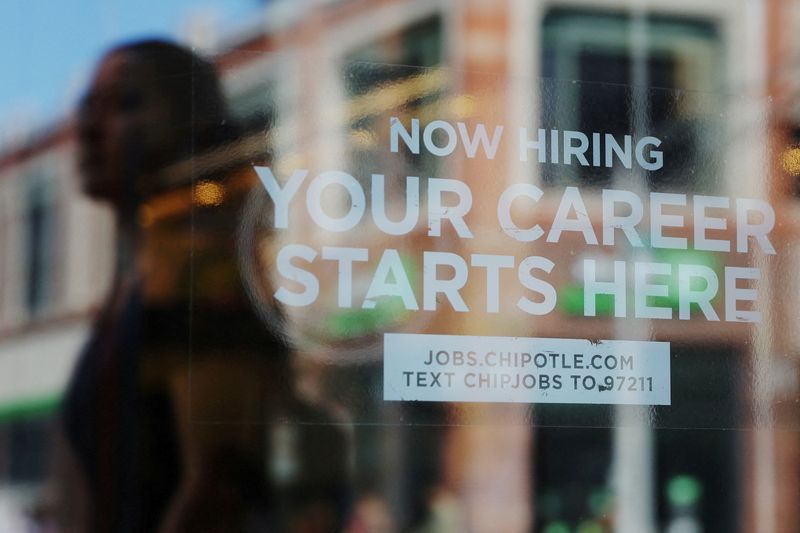By Howard Schneider
WASHINGTON (Reuters) - Data since the Federal Reserve's last policy meeting has added to the impression the U.S. economy is cooling without cracking, likely bolstering the case against further rate increases even if central bank policymakers are reluctant to call off their fight against inflation any time soon.
Since adjourning their July 25-26 policy meeting, employment reports - including downward revisions to earlier releases - showed job growth slipping from its torrid pandemic-era pace to one more comparable with the strong-but-sustainable labor market seen before the start of the global health crisis.
Though hiring in August was strong by historical standards, with 187,000 jobs added, employment gains over the last three months have averaged just 150,000, the lowest reading since the October-December period in 2019.
The rates at which workers are quitting as well as the pace of hiring also have slipped to near or below pre-pandemic levels, while one statistic closely watched by the Fed - the number of job openings for every unemployed person - tumbled in July to 1.51, the lowest since September 2021.
The downshift marks "a clear cooling of the labor market," former Boston Fed President Eric Rosengren said in comments posted on messaging platform X, formerly known as Twitter. "If it continues we are likely at the peak of the interest rate cycle."
The Fed has raised its benchmark overnight interest rate rapidly since March of 2022, but is expected at its Sept. 19-20 meeting to hold it steady in the current 5.25%-5.50% range. New economic projections issued at the end of that gathering will show if policymakers continue to expect an additional rate increase this year, but after the latest jobs data investors increased their bets against such a prospect.
Acting U.S. Labor Secretary Julie Su said the slower pace of job growth showed the economy was shifting from the "breakneck" recovery from pandemic-era job losses to "continued stable, steady growth ... This is really what you want to see if you are looking for a 'soft landing.'"
Her reference was to the hope among Fed policymakers that they can lower still-elevated inflation to the central bank's 2% target without forcing the economy into recession or causing high rates of joblessness.
Although the unemployment rate rose three-tenths of a percentage point to 3.8% in August, it remained well below the rates of 5% and higher that have been normal in the U.S. since World War Two. Moreover, it was driven by a jump of more than 700,000 in the number of available workers - a constructive dynamic that can allow employment to expand without inflationary pressure on wages.
'WELL-BEHAVED' DATA
The 0.2% gain in average hourly earnings last month was the smallest since February 2022 and equated to an annualized pace of around 2.5%, lower than the roughly 3% that Fed officials feel is consistent with their 2% inflation target.
The labor force participation rate rose two-tenths of a percentage point to 62.8%, and is now just half a percentage point below where it was prior to the pandemic and at a level some economists feel is roughly consistent with its underlying trend given population aging.
More subtle measures of the labor force also showed the sort of "stickiness" that economists point to as a sign of health. Along with people joining the job market, the labor force grew because more people who lost one job immediately began looking for another rather than dropping out or becoming discouraged.
Fed officials have been hoping to see the labor market cool, torn between the fact that rising wages and a good job market improve the economic fortunes of workers and families, and concern that continued strong hiring conditions could keep inflation high.
At least so far, the Fed is registering gains there as well, with data since the July meeting showing the pace of price increases slowing and the breadth of inflation narrowing.
Though the main U.S. inflation indexes did increase slightly in August on a year-over-year basis, the month-to-month pace has been slowing. Alternate measures that look at the spread of inflation across goods and services, like the median personal consumption expenditures (PCE) price index calculated by the Cleveland Fed, have also dropped in recent months, a potentially important cue for policymakers trying to distill underlying trends from noisy, month-to-month shifts in relative prices.
Headline inflation remains high, with the closely watched PCE price index, stripped of food and energy costs, registering a 4.2% annual increase in July.

But after saying they needed several months of steady improvement and evidence of a cooling economy to be confident interest rates were high enough, policymakers may finally have gotten the signal they need, said Ian Shepherdson, chief economist at Pantheon Macroeconomics.
August job growth "near 200,000 is not weak enough on its own to allow the Fed's hawks to relax," he said. "But neither is it strong enough for them to push for further rate hikes if other data - on both growth and inflation - are well-behaved, as we expect."